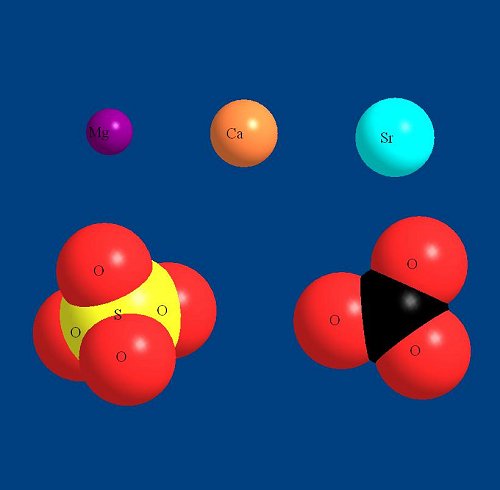Randy Holmes-Farley
Reef Chemist
View Badges
Staff member
Super Moderator
Excellence Award
Expert Contributor
Article Contributor
R2R Research
My Tank Thread
- Joined
- Sep 5, 2014
- Messages
- 67,390
- Reaction score
- 63,728
Test Strontium this morning and at 0ppm again so dosing it back up. Again, seeing good growth and not saying it simply because of the Strontium, but for it to be 0ppm again tells me that the corals are consuming it. I am as diligent as I can be using the Salifert test kit. Even purchase a new kit just to ensure I have good reagents.
...
Will see how fast it drops now that I have added some back to the system.
It is well established scientific fact that corals consume a fixed amount of strontium, relative to calcium and alkalinity, as does abiotic precipitation of calcium carbonate.
The reason is that strontium looks chemically very similar to calcium, just bigger. So some gets into the growing crystals by mistake (if no other way) in place of calcium and the amount that gets in is a precisely controlled function of the water temperature. Scientists have established that the strontium to calcium ratio in coral skeletons can be used as an indicator of the temperature of ancient oceans where corals and other organisms grew.
BUT, the incorporation of strontium is not evidence that it is useful or needed, which is made especially clear by the fact that simple chemical precipitation of calcium carbonate incorporates nearly the same amount of strontium (very slightly less), and by the fact that loads of other ions also get incorporated into coral skeletons that obviously are not needed (e.g., uranium) just because they get incorporated by replacing some of the calcium "by mistake".
I discuss these issues here:

Aquarium Chemistry: Strontium and the Reef Aquarium
This article on strontium is the second of several that delve into a variety of issues involving magnesium and strontium.
from it:
Organisms That Use Strontium: Corals and Calcerous Algae
Organisms that calcify (that is, deposit calcium carbonate skeletons) are known to incorporate strontium into them. This deposition may be:
- Intentional for positive reasons. That is, the strontium serves a useful purpose. Perhaps the purpose is to initiate or maintain calcium carbonate precipitation in some fashion. Some organisms described above clearly fall into this category.
- Intentional for negative reasons. That is, the organism wants to get rid of potentially toxic strontium and depositing it into a CaCO3 skeleton is one way to accomplish that task).
- Accidental. That is, the deposition of strontium serves no real purpose for the organism, but is simply the result of the fact that strontium looks rather like calcium, and gets into pathways intended for calcium and becomes deposited into the skeleton. This is obviously the way that strontium gets into abiotically deposited calcium carbonate.
This temperature dependence has lead many researchers to investigate, and find largely true, the idea that the strontium to calcium ratios in corals might be used as a temperature probe for ocean temperatures. Most interestingly, it has been extended into ancient coral skeletons, where actual temperature measurements are lacking.26 Many factors have complicated these studies, such as
- Different corals incorporate different ratios at the same seawater temperature and strontium levels,
- The same corals can deposit different ratios during the day and the night
- Different parts of the skeleton of a single coral may have different ratios
- The presence of zooxanthellae can significantly perturb the ratio.25
- The incorporation of strontium is strongly dependent on the strontium concentration in solution (which may vary over geologic time, with depth, and with salinity)
In any case, there are many fascinating studies reported related to strontium in corals and other calcium carbonate deposits. While many of these are only tangentially related to aquarium issues, some of the basic issues are important for understanding the strontium balance in aquaria.
In an old (1957) study28 of 900 samples of calcium carbonate from many different organisms, it was noted that:
- “Analyses of limestones, reef cores, limestone precursors, and fossils indicate that replacement and recrystn. lower the Sr/Ca ratio”. This fact is important because if calcium carbonate is the ultimate basis for calcium additives to aquaria (such as CaCO3 in CaCO3/CO2 reactors, or CaCO3 heated to form lime that is later used to make limewater), then the amount of strontium present in these ancient deposits will control the amount getting into aquaria. If these deposits are deficient in strontium, then an aquarium using them may also become deficient.
- “…reef corals, and green aragonite algae all have high Sr/Ca ratios that may be related to rapid deposition of carbonates associated with photosynthesis processes”. Again, if reef corals are not the ultimate source of CaCO3 used to make calcium supplements, then the levels in the aquarium may drop over time, just as in (1).
- “The Sr/Ca ratio is characteristic of a species or a taxonomic group…”
Many recent studies have shown the Ca:Sr ratio for many corals at typical tropical reef temperatures and at normal seawater strontium concentrations to be in the range of 100:1 to 120:1. When looked at very closely, it has been noted that corals do actually seem to incorporate slightly more strontium than happens abiotically under the same temperature and ambient strontium conditions (about 103:1 (at 25 °C).25 Is that because the corals “want” the strontium? Or just an artifact of the pathway that corals use to get calcium deposited29 into calcium carbonate? The answer is unknown, but there are a few clues buried in other studies, and these are described below.
















